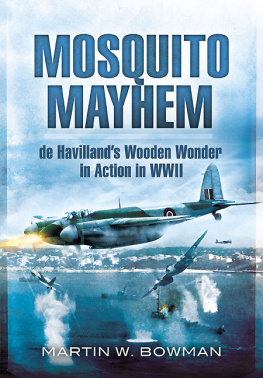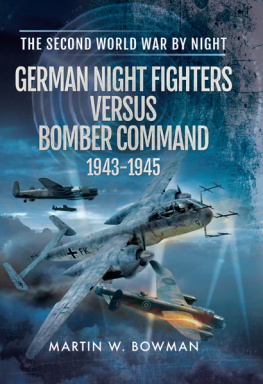
C ONTENTS
When Britain declared war on Germany in September 1939 RAF front-line bombers were mainly twin-engined types like the Hampden, Whitley and Wellington, but after suffering heavy losses by day these were used only on night operations which proved no less dangerous than the daylights had been. Lady Luck decided if they lived or died on ops. F ear, sweat, tension and dreaded bomb runs made most aircrew realise that the chance of survival and completing a tour before the Reaper caught them was slim. This was reflected in their unofficial anthem:
Lift up your glasses ready
For the air crew up there in the sky,
Heres a toast to the dead already
And heres to the next man to die.
Bomber Command sank 55 per cent of the German merchant fleet, and together with Coastal Command, sank three-quarters of the U-boats lost by Germany. In 1942 Sir Arthur Harris became commander of Bomber Command. He began massive raids, which did not cease until the final surrender of Germany. By early 1944 fierce air battles involving four-engined Lancasters and Halifax aircraft raged over the skies of Germany and Reich territory. Approximately 125,000 aircrew served in the RAF, RAAF, RNZAF, RCAF, Polish squadrons and the operational training and conversion units. M ost were plucked from Civvy Street where t he sight of devastation made many feel that at least they had joined the right service because only Bomber Command was capable of attacking the enemy. It was also refreshing to many young minds to know that soon, with good luck, they would be in a crew that would be dropping bombs on the enemy.
The vivid, poignant and descriptive personal experiences of the bomber crews carrying the war to the enemy in the night bomber offensive in the Second World War are recounted, mostly at first hand, sometimes in wartime broadcasts to the nation.
Of the 7,953 Bomber Command aircraft lost on night operations during the Second World War, an estimated 5,833 fell victim to German night fighters. Nearly 60 per cent of Bomber Command aircrew became casualties. Approximately 85 per cent of these casualties were suffered on operations and 15 per cent in training and accidents. Fatal casualties to aircrew totalled 55,500 and 9,838 were taken prisoners of war and 4,203 were wounded in flying or ground accidents in the UK. Total aircrew casualties numbered 73,741.
I have pieced together official data and the words and memories of the RAF and Dominion pilots and aircrew, detailing many unique experiences during the night bombing raids that were hurled against Hitlers war machine. This collection of first-hand accounts gives a really good feel for the variety of the RAFs bomber war, from the earliest limited attacks of 1939 to the overwhelming raids of 194445 and a good cross section of what happened between.
Each chapter is the result of meticulous research and, in many cases, converting the anonymous into real people. Some of the stories emanate from wartime publications that were censored and so their names, units and actions were generally anonymous and unknown to the British public until long after the war. Although the actions covered were real many of the names applied to these actions were fictitious.
Recent years have seen an upsurge in the popularity of the memories and experiences of the ordinary man at war. Perhaps this is down to a realisation that, as time passes, their memories might be lost. Their accounts are stirring, gripping and memorable, and not preoccupied by strategy or tactics, but rather the emotional aspect of war.
The storytellers are an eclectic mix of pilots, navigators, bomb aimers, wireless operators and gunners who flew on operations in heavy bombers. It conveys the terror of being coned by German searchlights over the target, attacks by Luftwaffe night fighters, often catastrophic damage to aircraft and the ensuing struggle to keep the machine airborne on the return trip to base. It tells of the comradeship between the crew and conveys the sense of purpose that these men felt in doing one of the most dangerous jobs in the war. These truly epic stories are a fitting tribute to those who survived and the many thousands who died in the struggle against Hitlers dreadful ambitions in Europe, and are an appropriate epitaph to the men of RAF Bomber Command.
As Churchill said: Britain can never repay them as they should have been repaid for the huge sacrifice they made to ensure our freedom.
Martin W. Bowman
1
F LIGHT L IEUTENANT
R ODERICK L EAROYD
The Germans worked hard to repair the damage to the DortmundEms Canal after the raid on 1920 June 1940 and they also defended the canal so well with searchlights and guns that they probably considered it impossible for any aircraft ever again to make a successful attack on the waterway. Nevertheless, the RAF went back from time to time to do their worst. On one occasion Acting Flight Lieutenant Roderick Alastair Brook Babe Learoyd on 49 Squadron acted as a decoy to draw the fire of the defences while other bombers slid down to attack; another time he made a high-level attack. He was, thus, not unfamiliar with the DortmundEms Canal when he started out to make his third attack upon it on 1213 August, when two Hampden units, 49 and 83 Squadrons in 5 Group, carried out a low-level raid. It was a night of half moon, which gave sufficient light in which to see the target. The Hampdens carefully timed their attack so as to drop the special charge at intervals of exactly two minutes, beginning at 01.30. At one point the canal was especially vulnerable. North of Mnster, two aqueducts, one on four arches, the other on two, carried the canal across the River Ems. The width of each channel was only 100ft at water level.
To destroy both aqueducts meant cutting the canal entirely, while the destruction of one would greatly reduce the volume of traffic passing through it. The aqueduct was heavily protected by anti-aircraft guns disposed so as to form a lane down which an attacking aircraft must fly if it was to reach the target, but it was decided to attack from a very low level in order to make certain the target would be hit. One by one, the eleven Hampdens went in from the north, the moon shining in the faces of their crews and throwing the objective into relief. The first aircraft was hit and the wireless operator on board wounded; the second was hit and destroyed. The third was set on fire, but before the aircraft became uncontrollable, the pilot succeeded in gaining enough height to enable the crew and himself to bail out. They did so and were made prisoners. The fourth Hampden was hit in three places but got back to base. The fifth and last Hampden, piloted by Flight Lieutenant Learoyd, went down the anti-aircraft lane at 200ft.
After a moment three big holes appeared in the starboard wing. They were firing at point-blank range. The navigator continued to direct me on to the target. I could not see it because I was blinded by the glare of the searchlights and had to keep my head below the level of the cockpit top. At last I heard the navigator say Bombs gone; I immediately did a steep turn to the right and got away, being fired at heavily for five minutes. The carrier pigeon we carried laid an egg during the attack.
The attack achieved an element of surprise and the damage to the canal restricted barge traffic on this important waterway for a number of weeks. Learoyd was awarded Bomber Commands first Victoria Cross of the war. His VC citation read:
This officer, as first pilot of a Hampden aircraft, has repeatedly shown the highest conception of his duty and complete indifference to personal danger in making attacks at the lowest altitude objective on the DortmundEms Canal. He had attacked this objective on a previous occasion and was well aware of personal danger in making attacks at the lowest altitude objective on the DortmundEms Canal To achieve success it was necessary to approach from a direction well known to the enemy, through a lane of especially disposed anti-aircraft defences and in the face of the most intense point blank fire from guns of all calibres. The reception of the preceding aircraft might well have deterred the stoutest heart, all being hit and two lost. Flight Lieutenant Learoyd nevertheless made his attack at 150ft, his aircraft being repeatedly hit and large pieces of the main planes torn away. He was almost blinded by the glare of many searchlights at close range but pressed home this attack with the greatest resolution and skill. He subsequently brought his wrecked aircraft home and, as the landing flaps were inoperative and the undercarriage indicators out of action, waited for dawn in the vicinity of his aerodrome before landing, which he accomplished without causing injury to his crew or further damage to the aircraft. The high courage, skill and determination, which this officer has invariably displayed on many occasions in the face of the enemy, sets an example which is unsurpassed.
Next page

















